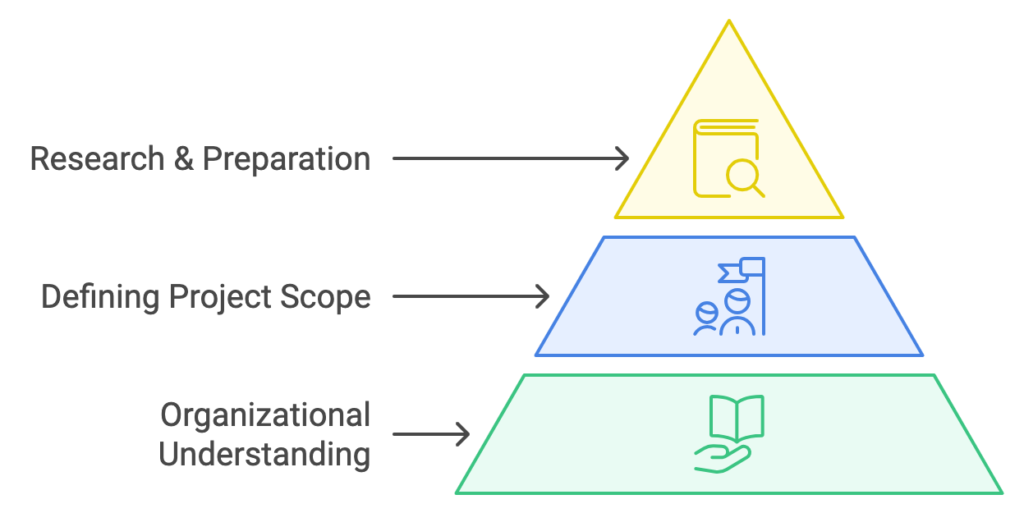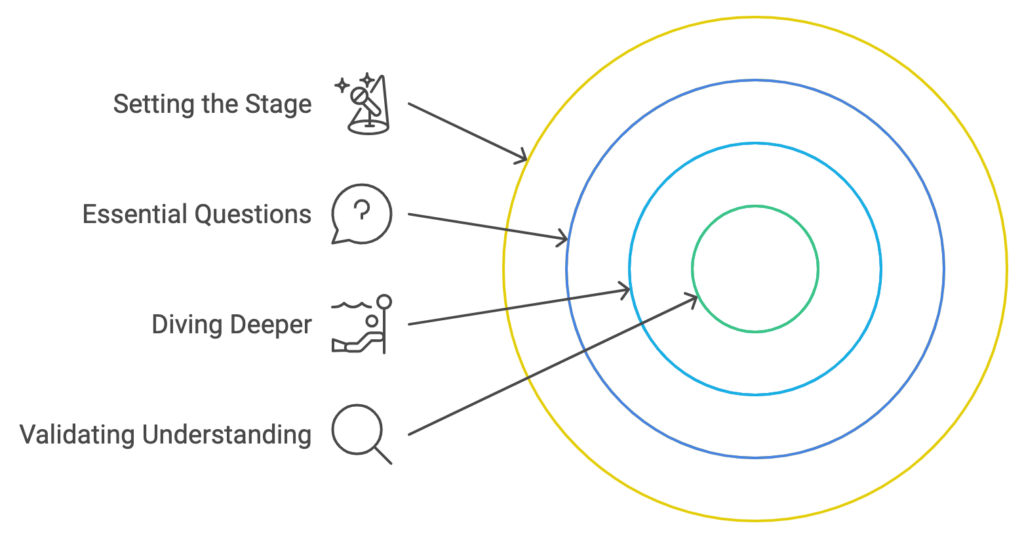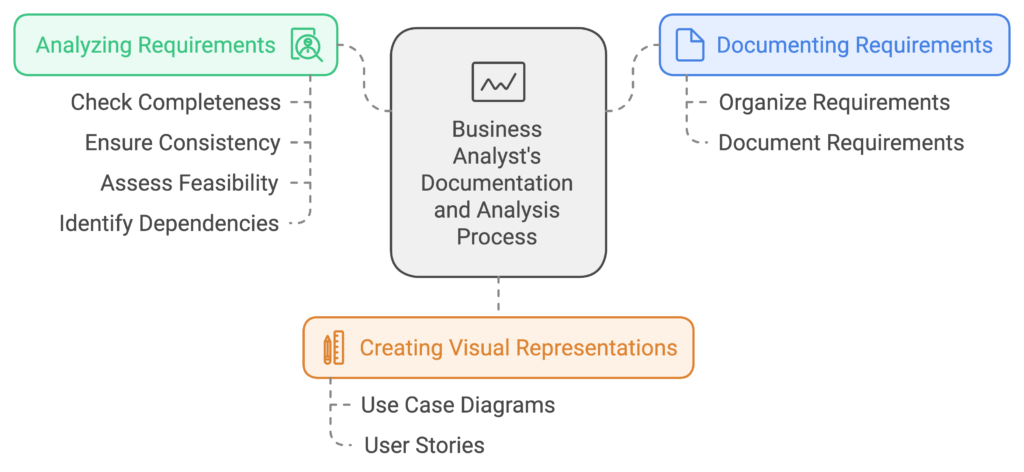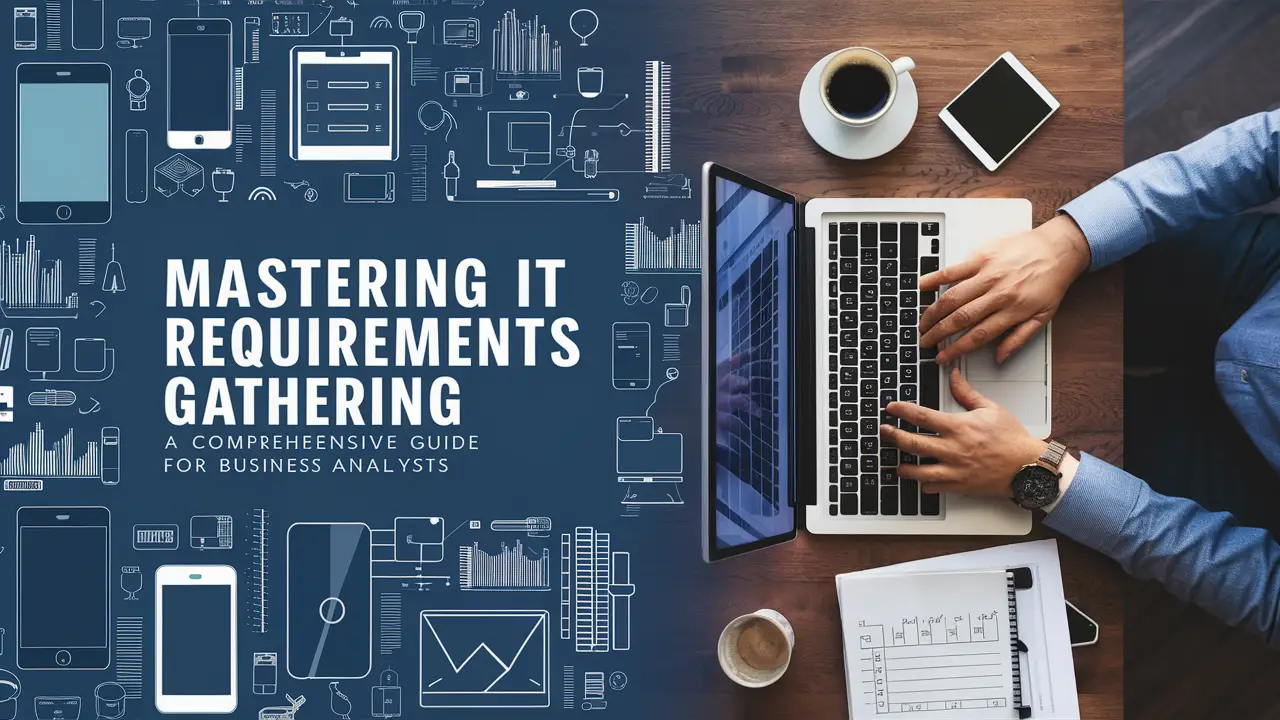Introduction: The Business Analyst’s Role in Requirements Gathering
As a business analyst, your ability to gather accurate and comprehensive IT requirements is crucial for project success. This guide will equip you with the skills to ask the right questions and highlight why a deep understanding of the organization is essential for every business analyst.
Part 1: The Business Analyst’s Preparation for Requirements Gathering

Step 1: The Business Analyst’s Organizational Understanding
- Study the company’s mission, vision, and strategic goals
- Learn about the organizational structure and key stakeholders
- Familiarize yourself with the company’s products, services, and market position
- Understand the regulatory environment and industry standards
- Review existing business processes and workflows
- Analyze the current IT infrastructure and systems landscape
Step 2: The Business Analyst’s Approach to Defining Project Scope
- Identify the project’s objectives and alignment with business goals
- Determine the departments and processes affected by the project
- Establish project boundaries and constraints
- Identify key stakeholders and their roles in the project
Step 3: The Business Analyst’s Research and Preparation
- Review relevant documentation (e.g., process maps, system documentation)
- Analyze similar projects or case studies within the industry
- Prepare a list of initial questions based on your research
- Create a requirements gathering plan and schedule
Part 2: The Business Analyst’s Guide to Conducting Requirements Gathering Sessions

Step 4: How Business Analysts Set the Stage
- Explain the purpose of the session and expected outcomes
- Establish ground rules for the discussion
- Encourage open communication and participation from all attendees
Step 5: Essential Questions for Business Analysts to Ask
General Questions for Business Analysts:
- What are the primary business objectives this project aims to achieve?
- How does this project align with the organization’s strategic goals?
- What are the current pain points in the existing process or system?
- Who are the primary users or beneficiaries of this solution?
- What are the critical success factors for this project?
Process-Specific Questions for Business Analysts:
- Can you walk me through the current process step-by-step?
- Where are the bottlenecks or inefficiencies in the current process?
- What are the inputs and outputs of each step in the process?
- How do you measure the success or effectiveness of this process?
- Are there any regulatory or compliance requirements that affect this process?
System-Specific Questions for Business Analysts:
- What functionalities are essential for the new system?
- How should the system integrate with existing tools and processes?
- What data needs to be captured, processed, or reported by the system?
- What are the performance expectations for the system (e.g., speed, capacity)?
- What security and access control requirements are necessary?
User-Centric Questions for Business Analysts:
- Who are the different user groups, and what are their specific needs?
- What tasks do users perform most frequently?
- What information do users need to access quickly or regularly?
- Are there any usability or accessibility requirements to consider?
- How tech-savvy are the users, and what level of training might be required?
Future-Proofing Questions for Business Analysts:
- How do you foresee this process or system evolving in the next 3-5 years?
- Are there any planned organizational changes that might impact this solution?
- What scalability requirements should we consider?
- How flexible does the solution need to be to accommodate future changes?
Step 6: How Business Analysts Dive Deeper
- Use the “5 Whys” technique to uncover the root causes of issues
- Ask for specific examples or scenarios to illustrate the requirements
- Explore edge cases and exception handling
- Discuss potential risks and mitigation strategies
Step 7: The Business Analyst’s Approach to Validating Understanding
- Summarize key points and decisions made during the session
- Use visual aids (e.g., diagrams, mockups) to confirm understanding
- Ask stakeholders to prioritize requirements
- Identify any areas of uncertainty or conflict for further investigation
Part 3: The Business Analyst’s Post-Session Activities

Step 8: How Business Analysts Document and Analyze
- Organize and document all gathered requirements
- Analyze requirements for completeness, consistency, and feasibility
- Identify dependencies between requirements
- Create visual representations of requirements (e.g., use case diagrams, user stories)
Step 9: The Business Analyst’s Follow-Up and Refinement Process
- Share documented requirements with stakeholders for review
- Conduct follow-up sessions to address gaps or inconsistencies
- Refine requirements based on feedback and further analysis
- Obtain formal sign-off on final requirements
Step 10: Continuous Learning and Improvement for Business Analysts
- Reflect on the requirements gathering process and identify areas for improvement
- Stay updated on industry trends and best practices
- Continuously expand your knowledge of the organization and its evolving needs
- Seek feedback from stakeholders and team members on your performance
Conclusion: The Business Analyst’s Path to Success in IT Requirements Gathering
Gathering effective IT requirements is a critical skill for every business analyst. It requires a combination of deep organizational knowledge, strong communication skills, and a systematic approach. By following these steps and continuously improving your skills, you’ll be well-equipped to ask the right questions and gather comprehensive, accurate requirements for your IT projects.
Remember, the key to success as a business analyst lies in your ability to understand the big picture while also diving into the details. Stay curious, be thorough, and always strive to align technology solutions with business objectives. Your role in bridging the gap between business needs and technical solutions is invaluable to the success of any IT project.
FAQ: Common Questions for Business Analysts on IT Requirements Gathering
Q1: What is the role of a business analyst in IT requirements gathering?
A business analyst plays a crucial role in IT requirements gathering by bridging the gap between business needs and technical solutions. They are responsible for eliciting, analyzing, validating, and documenting requirements from stakeholders to ensure that the final IT solution meets the organization’s objectives.
Q2: How can a business analyst improve their requirements-gathering skills?
Business analysts can improve their requirements gathering skills by:
- Continuously learning about the organization and industry
- Developing strong communication and active listening skills
- Practicing various elicitation techniques (interviews, workshops, surveys)
- Staying updated on latest technologies and methodologies
- Seeking feedback and learning from each project experience
Q3: What are some common challenges business analysts face during requirements gathering?
A common challenges include:
- Stakeholders with conflicting requirements
- Unclear or changing project scope
- Communication gaps between technical and non-technical stakeholders
- Incomplete or ambiguous information
- Resistance to change from certain stakeholders
Q4: How does a business analyst prioritize requirements?
A Business analysts prioritize requirements by:
- Aligning them with business objectives and strategic goals
- Considering the impact on users and business processes
- Evaluating the technical feasibility and complexity
- Assessing the cost-benefit ratio of each requirement
- Collaborating with stakeholders to reach a consensus on priorities
Q5: What tools do business analysts typically use for requirements gathering?
A Business analysts often use tools such as:
- Requirements management software (e.g., Ellogy, Jira, Trello)
- Diagramming tools (e.g., Visio, Lucidchart)
- Collaboration platforms (e.g., Microsoft Teams, Slack)
- Prototyping tools (e.g., Axure, Balsamiq)
- Survey tools (e.g., SurveyMonkey, Google Forms)
Q6: How does a business analyst validate gathered requirements?
A Business analysts validate requirements by:
- Reviewing them with stakeholders for accuracy and completeness
- Creating prototypes or mockups for visual validation
- Conducting walkthroughs of use cases or user stories
- Performing traceability analysis to ensure alignment with business objectives
- Facilitating formal sign-off sessions with key stakeholders
Q7: What’s the difference between functional and non-functional requirements?
A Functional requirements describe what the system should do, specifying particular behaviors or functions. Non-functional requirements specify criteria that can be used to judge the operation of a system, rather than specific behaviors. Examples of non-functional requirements include performance, security, and usability.
Q8: How does a business analyst handle changing requirements during a project?
To handle changing requirements, a business analyst should:
- Establish a clear change control process at the project’s outset
- Document all proposed changes and their potential impacts
- Analyze the effect of changes on project scope, timeline, and resources
- Communicate changes to all relevant stakeholders
- Ensure proper approval and prioritization of changes
- Update requirements documentation and project plans accordingly
Q9: How can a business analyst ensure that technical and non-technical stakeholders are on the same page?
To align technical and non-technical stakeholders, a business analyst can:
- Use visual aids like diagrams and prototypes to illustrate concepts
- Avoid technical jargon and explain technical concepts in simple terms
- Facilitate workshops bringing both groups together
- Create a glossary of terms to ensure a shared understanding
- Regularly check for understanding and encourage questions
Q10: What’s the importance of organizational knowledge for a business analyst in requirements gathering?
Organizational knowledge is crucial for a business analyst because it:
- Helps in understanding the context of requirements
- Enables the analyst to ask more insightful questions
- Assists in identifying potential impacts across different departments
- Allows for better alignment of requirements with organizational goals
- Enhances the analyst’s credibility with stakeholders





